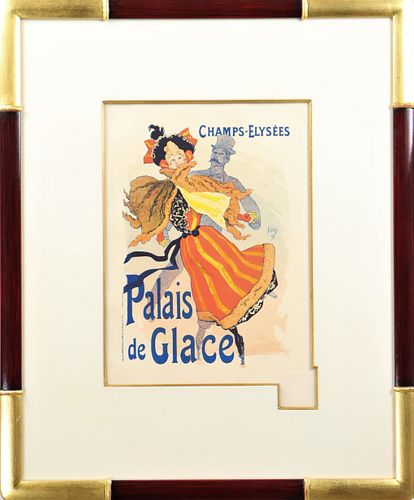A colorful French framed poster by Jules Cheret, known for his advertising posters. "Palais de Glace" of a man and woman dancing.
Considered the creator of the modern approach to poster making, Jules Cheret did work with coloration and perspective that "caused a revolution, a color revolution" and likely inspired the Fauve painters whose colorful works were first publicly exhibited in 1933, the year after his death. Because of his innovations, "there was fun and fantasy, glimpses of laughter, whirling of dancers decorating the kiosks of Paris, dazzling the senses and creating a movement of gaiety that had not existed before."
painter in oil and pastel as well as lithographer, was raised in Paris in a poverty level family of artistans. His schooling ended when he was age 13, and his father, who was a typographer, arranged a three-year apprenticeship with a lithographer, who could teach the young man what was then the prevailing method of design reproduction. Cheret did much research and experimentation with design processes, and in 1858, created his first poster, which was for the composer Jacques Offenbach. Frustrated with his lack of success to sell music-theme sketches to publishers, he worked in London in the 1860s to enhance his education. There he worked for The Maple Furniture Company and for Cramer, a publishing firm doing circus, theater and music-hall posters, but he was not happy with these experiences.
In 1866, Cheret returned to Paris, opened a studio and began the creative method of printing theatrical posters that made images seem vital and three dimensional and that attracted much public acclaim with their vivid colors. He also incorporated much text into his posters, which was an innovation.
Of his work, it was written that he "depicted inviting, unframed scenes of figures caught in mid action" and that his unusually copious amount of lettering "brought the advertising component of his designs into prominence." He initially worked in only one or two colors, but then "introduced a new system of printing from three stones: one black, one red and the third a 'fond gradué", which was the creation of two colors from one stone with the top having the cool colors and the bottom the warm colors. With this process, he did what no other printmaker had ever done, and in the 1870s and 1880s, he worked productively creating posters with this method of achieving complementary colors.
With advancing years, Cheret spent more and more time in Nice with his wife, and often they were seen strolling the streets. "He is described as an elegant man, slim and handsome." By 1925, his eyesight had failed, and seven years later he, age ninety-six, died.
Overall size: 24 1/2 x 19 in.
Sight size: 13 1/2 x 10 in.
Please note that all sales are final. No refunds will be given under any circumstances.
Available payment options
We accept all major credit cards, wire transfers, money orders, checks and PayPal. Please give us a call at (941) 359-8700 or email us at SarasotaEstateAuction@gmail.com should you have any questions about payment.






